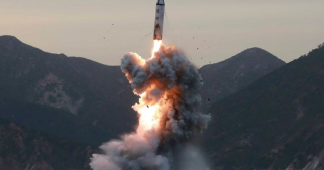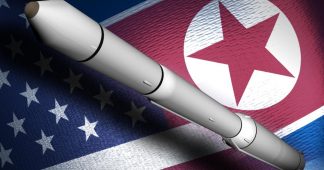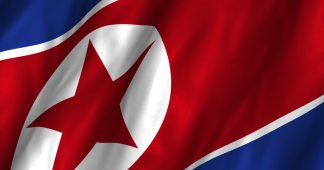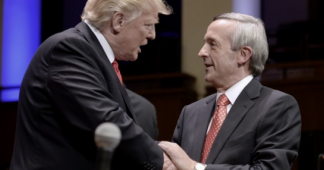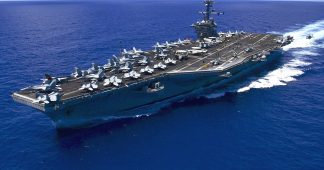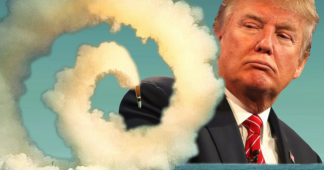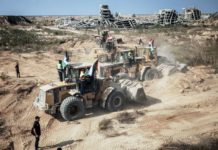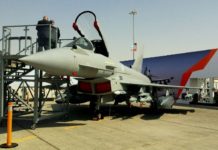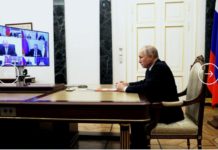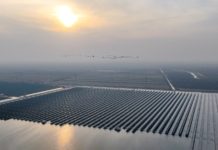Pyongyang can miniaturize, so let’s move on to what’s important: David Wright on the North Korea crisis
By Lucien Crowder
On Tuesday, The Washington Post set the arms control community abuzz with its reporting on a US intelligence assessment that North Korea had gained the capability to make nuclear warheads small and light enough to be mounted on Pyongyang’s newly operational intercontinental ballistic missiles. Later the same day, President Trump set a much larger cross-section of the world abuzz with his declaration that North Korea would “be met with fire and fury like the world has never seen” if it continued to issue threats toward the United States. Soon the nuclear stand-off on the Korean Peninsula, often described as a Cuban Missile Crisis in slow motion, began to feel like a Cuban Missile Crisis in real time. But according to David Wright—an expert on nuclear and missile issues with the Union of Concerned Scientists—the Post story contains few real surprises and Trump’s “fire and fury” rhetoric is unlikely to alter the basic calculus of self-preservation that stands paramount in Pyongyang. Still, Wright argues, a “crisis mentality” and an error of some kind could add up to disaster on the peninsula.
Bulletin: First, I wonder if you could clarify one point just for my understanding. My reading of Tuesday’s Washington Post story is that this new intelligence assessment about miniaturization is delivered by the Defense Intelligence Agency (DIA), but it represents a summary assessment of the entire intelligence community. Have I got that right?
David Wright: I have wondered that myself. People I’ve talked to point out that the DIA has released several presumably classified assessments about North Korea recently and wonder what’s going on, and whether these are consensus views or DIA views. Statements by officials in other parts of the intelligence community suggest there are other views, so I’m not sure what to think at this point.
Bulletin: I understand that you don’t have access to all the same information that the intelligence community has, but do you know of concrete information that justifies a change in assessment regarding miniaturization?
DW: No. I don’t know what that’s based on.
Bulletin: So there’s nothing new here that we can see.
DW: I think that’s right—though it doesn’t particularly surprise me. But I don’t know why they’ve come out with this now.
Bulletin:I wonder if you could quickly explain what’s hard about miniaturization in the first place.
DW: If you’re trying to develop a nuclear weapon, and you want a device that will go off, you tend to not worry about minimizing everything as much as you could. You tend to use more fissile material than you think you probably need. You tend to use more high explosives so you get a good compression. Once you have that working, then you have to figure out “How can I shave off some of the mass and still have a reliable warhead? How do I make sure that I’ve gotten the masses down to the point that I’m comfortable with and still believe that I have enough reliability and confidence that this thing will go off when I want it to?”
Bulletin: Are there different stages of miniaturization capability? For instance, is it one thing to miniaturize enough for a short-range missile, but a different thing to miniaturize for a medium-range missile or an intercontinental ballistic missile (ICBM)?
DW: Well, in practice it is, because if you look at developing ballistic missiles, it turns out that it’s relatively easy to make short-range missiles. So, for example, with the Scud missile that the Soviets were building, the body was made of steel, it carried a tonne warhead, and yet they could still put an engine in it that would get it up to high enough speed that it could go for 300 kilometers. Now, the problem is that once you try to increase the range, it gets harder and harder. So what you want to start doing is shaving mass off wherever you can, and so you start making the body out of lighter-weight materials. That gets you a certain distance. But at some point you decide you want to start staging because, if you use multiple stages, you burn part of the fuel and then drop the casing for that, and you’ve got less mass to accelerate. As you go longer and longer in range, you’re trying to do more and more to shave off mass. Launching one tonne on a short-range missile would be relatively easy. Launching that same mass on a long-range missile is quite a bit more difficult. For that purpose, you’d like to have a lighter-weight warhead to carry.
And the same is true with the re-entry vehicle. You also want to have the heat shield that can get the thing down through the atmosphere at these high speeds, and that also gets harder and harder for long range because it re-enters at higher and higher speeds. That means you’ve got more and more heating. And again, you’d like to convince yourself that you’ve shaved off as much mass as you can, but that you still have enough left to protect the warhead and not to mechanically fail during re-entry. So all those things add up to pretty serious engineering problems.
Bulletin: I’ve got a couple of questions about re-entry, actually. What’s your assessment of the timeline reported in the Post story that the North will be able to field a workable re-entry vehicle by late next year?
DW: I think that that’s probably right, assuming they haven’t already done it. There are trade-offs with re-entry vehicles. The easiest way to get a warhead down to the ground and not have it overheat is to have a very blunt warhead and have it slow down high in the atmosphere, so that by the time it gets to the lower part of the atmosphere—where the atmospheric density is higher—it’s moving much slower and the heating is less intense. And if you think about it, the early Mercury and Gemini capsules came in basically backwards, and they had that very broad back end. It was their way of dealing with the heating, it slowed them down very high in the atmosphere and they came down much more slowly. I think there’s no doubt that North Korea could put a fairly blunt re-entry vehicle on its warheads and get them to the ground without a problem on the heating.
The problem is that, when you slow down the re-entry through the atmosphere, you get much higher inaccuracy. Now, that may or may not be a problem [from North Korea’s perspective]. There are sort of two large parts to the inaccuracy of a blunt missile. One is that you aim a missile by controlling its speed and the angle it’s going when the engines burn out a couple of minutes after it’s launched. Now, if you don’t have very good control over both the angle and the speed, or if you don’t have a very good accelerometer in the missile—so it doesn’t know exactly how fast it’s going—then all those things will add up, especially for a long-range missile, to a big miss distance. And similarly, atmospheric winds, density variations, whether it’s wobbling or tumbling—all those things put lateral forces on it, and so again, you can get a big contribution to errors due to re-entry. And so if North Korea was launching a long-range missile at a target, I think they’d be lucky to get within tens of miles of that point.
So you can ask yourself, well, “How worried should they be about losing a little bit more accuracy by having a blunt warhead on re-entry?” I don’t know how they’re thinking about that trade-off. But certainly they could deal with re-entry by having a blunter body. Now in the last launch, on July 28th, there is some video footage from a camera in Japan that seems to show a glowing body coming down during re-entry, and then it stops glowing at some point. And the interpretation that some people have is that it got to the point that it mechanically failed and broke up a couple of kilometers above the ground. I don’t know if that’s right. It’s not a crazy interpretation of what we’re seeing, but I’m not sure it’s the right interpretation. If it’s true, it may mean that North Korea is sort of pushing the envelope on this, and is trying to increase its accuracy by having a relatively streamlined re-entry vehicle, and that has caused them to run into some problems. But I don’t see that as a fundamental problem. I think they could design, as I was saying before, a more blunt re-entry vehicle that would allow the warhead to get to the ground.
Bulletin: If they’re satisfied with hitting a target the size of Los Angeles… somewhere…
DW: Yeah, which is I think the best they can do anyway, for the foreseeable future. Getting long-range missile accuracy down below kilometers is really difficult. If you look at the extent of the work that the US and Soviet Union did on really getting the details of guidance and control down, on mapping the gravitational field of the Earth so they could do the calculations to figure out more accurately how they should aim it—and then they worked very, very hard on coming up with new materials and ablative coatings on their warheads and figuring out how to make that coating work in a symmetric way. It took a tremendous amount of work. So I think for the foreseeable future, North Korea is talking about city-sized inaccuracy for its warheads.
Bulletin: I see. So the biggest technical problem facing them at this point isn’t exactly miniaturization and it isn’t a workable re-entry vehicle. It’s good targeting.
DW: Yeah… Although, again, if what you’re trying to do is hit Los Angeles, that’s a pretty damn big target.
Bulletin: Returning to ICBMs themselves, it sounds as if there’s a consensus that North Korea has been testing what you could call ICBMs, but that view isn’t entirely universal. So in your opinion, putting aside re-entry and miniaturization, is the belief that North Korean missiles can now reach the continental US well-founded?
DW: Oh, absolutely. So… let me put a caveat on that. Take the most recent launch, July 28th. The information I had was a range of about 1,000 kilometers; the flight time, when they shot it up on a highly lofted trajectory till it came down, which was about 46, 47 minutes; and the maximum altitude that it went up to, which was, I think, about 3,700 kilometers. So what I did was to model these things in my computer and I said “Let me look at a missile that would have enough speed to go up to 3,700 kilometers and then come down at a range of 1,000 kilometers. How long does that fly?” And it turns out it’s about 46, 47 minutes. So those numbers were all consistent with each other. And we’ve seen from what North Korea has released that that’s sort of what they were trying to do. So I think there’s agreement that that’s basically what they did.
And then you can ask the question, well, if you have a missile that gives you enough speed to fly that trajectory, and instead of shooting it almost straight up, you shot it on a more standard trajectory for an ICBM, how far would it go? That gives you well, well over ICBM range. I think the major hold-out on this [issue] has been the Russians. The Russians seem to have political reasons for not wanting to admit that North Korea has long-range missiles. They have been giving some very odd information about what they’ve seen, which seems to sort of correspond just to the first stage of this missile. I don’t think anybody really understands why the Russians seem to be saying that North Korea doesn’t have ICBM capability. As far as I can tell, everybody else [believes North Korea has ICBM capability]. If the information that came out about the lofted trajectory on July 28th is right, that same missile would definitely have ICBM capability along a standard trajectory.
Bulletin: Returning to an earlier theme—correct me if I’m wrong, but it seems to me that the intel community consistently estimates North Korea’s capabilities higher than many nongovernmental experts might, or at least they reach conclusions about new capabilities more quickly than outside experts do. That seems to apply to miniaturization, to arsenal size, and so forth. Why do you think these estimates come out on the high side? Does the intelligence community just know more than everyone else? Do they assess better than everyone else? Or is my impression wrong to begin with?
DW: What we saw for a long time was the intelligence community coming out with estimates of—I’m going back 15 years or so—they were coming up with estimates for when they thought North Korea might have a long-range missile. And those tended to be on the short side. They tended to see this capability coming faster than most outside experts did. We don’t know the details of the analysis, but it could have been a worst case—if you’re trying to plan for this stuff and you don’t want to be taken by surprise. So that was a case where most outside experts, having watched the program, thought that the intelligence coming out was too aggressive. My sense is, more recently, that hasn’t necessarily been true. There are certainly outside experts who have been saying for quite some time that they thought North Korea had the ability to miniaturize. Jeffrey Lewis [director of the East Asia Nonproliferation Program at the Middlebury Institute of International Studies] is a good example of that. There are certainly others. I’ve come around to that view for some time now. Some people have said that it looks like when it was convenient to overestimate the threat—for example, to buttress the funding for missile defense—they did that. Now, when it’s starting to look like a more serious threat and they don’t know what to do about it, they’re sort of hedging their bets a little bit. I’m not sure there’s a clean answer to that, to be honest—who’s overestimating and who’s underestimating. Because I know there have been, certainly, frustrations. Jeffrey Lewis is one of the key people—he’s been very frustrated with a lot of assessments of North Korea that seem to downplay their ability to do some of the things that they appear to have done.
Bulletin: I see. Well, in any case it sounds more complicated than I thought it was. In your own calculations and assessments about North Korea, what are the greatest areas of uncertainty for you? Where do you have the most trouble deciding what you believe?
DW: Well, [regarding] missiles with very long ranges, one of the things we don’t understand is what payload those were launched with. For example, if you look at the July 4th launch, which we estimated to have a range of something like 7,000 kilometers if it was fired as an ICBM, and then you look at the July 28th launch, which had a much longer range than that—longer than 10,000 kilometers—in my modeling I could cause that difference by assuming that the July 4th test had essentially a full warhead in it, maybe half a tonne, and the July 28th test had a much smaller payload. [That is], they might not have put in the full mass of a mock warhead—they might have sort of flown the re-entry vehicle empty. So one possibility is that they wanted to really make the point that they could hit the US, and they off-loaded payload to get that longer range. On the other hand, there are things we see they could have done, in terms of some modifications to the second stage of the missile, that may have allowed them to reach these longer ranges with sort of a full-size payload that would be comparable to a nuclear warhead. That’s one of the really interesting questions that we’re trying to look at in the modeling. If we make reasonable assumptions about what this missile looks like, can we start to get a feel for whether or not this long range was achieved with a large payload or not?
Bulletin: On to my next-to-last question. Please share your thoughts on the fire and the fury.
DW: I think, and a lot of people agree with this, that Kim Jong-un may be a despicable human being, but he’s not irrational. I think he recognizes that, if he launched an attack, it would lead to a response that would destroy his regime, and one of the things that he really cares about is staying in power and keeping the regime alive. So I don’t expect him to wake up one day and just decide to launch at Los Angeles or Tokyo. What I am concerned about is that, as tensions increase between North Korea and the United States, and they get in a crisis mentality, something could happen—by mistake, by misinterpreted signal, things like that. And in particular, if you read some of the official statements that have come out of North Korea in the last couple of days, they go through a list of things that they say they see the US doing, like reinforcing bombers on Guam, and using those bombers to do overflights of the Korean Peninsula. They say the United States has conducted more ICBM flight tests out over the Pacific than they have in the past. So North Korea is starting to see activity that they can interpret as threatening. There’s about to be another set of exercises involving the United States and South Korea, which North Korea sees as practice for an invasion of the North. It seems to me when you add these bellicose statements [in which] the United States is threatening to use what, from the wording, certainly sounded like nuclear weapons, it makes me even more worried about a really devastating crisis because of miscalculation, misperception. Using language like that and continuing to up the ante—I worry about that quite a bit. What I really think the US needs to do is just the opposite, try and calm things down and make sure they don’t get out of control. Then, through diplomatic effort, try to open a line of communication with North Korea that, for example, would put a freeze on testing nuclear weapons and missiles, and try to set the stage for a longer-term negotiation that would deal with some of the more fundamental issues.
Bulletin: What chances do you give the scenario you just described?
DW: You know, I wish I knew the answer to that. We’re hearing from military advisors like Secretary of Defense Mattis that there’s no good military option. We’re hearing from [Secretary of State] that we are not enemies of North Korea, we are not trying to do regime change. You’re hearing the right words from those people—that they recognize that diplomacy is the best of all the bad options on the table. On the other hand, you’re hearing things like the stuff that was coming from President Trump [on Tuesday], which seems to undercut all that. Having watched President Trump for six months now, it’s clear that he likes to—and I think he sees this as part of his bargaining—come out with really strong positions and then walk back from there. And maybe that’s what he’s doing. In the past, he has said he’d be willing to sit down, talk, have a hamburger with Kim Jong-un. The problem is, I don’t think anyone knows where the center of that discussion in the administration is.
One of the things that the Trump administration has put a lot of hope on is China solving this problem. I think people should recognize that that’s not going to happen, for a couple of reasons. One is that China sees the situation very differently. First, they don’t feel like they have as much leverage as the United States thinks they do—without causing real instability in the region. And they also see this as fundamentally an issue between North Korea and the United States, and feel it has to be resolved by those two countries. So I think they’re willing to facilitate negotiations, but they’re not going to solve the problem. They also look at North Korea at this point and, according to people we’ve talked to over there, see themselves back in the 1960s and 1970s, when they were developing a nuclear program and were being sanctioned by the outside world. It basically strengthened their resolve to move forward with these programs. For that reason they believe that isolating North Korea and trying to starve it out is not going to work, and it’s going to be destabilizing. That’s one of the reasons they’ve continued to trade with North Korea. I think they feel that, in the same way that they were able to come out of that [experience] and become a more normal country, economic stability and some development of North Korea might help. Now, they may be wrong, but I think this idea that they’re somehow going to strangle North Korea for the United States is not going to help.
If the administration realizes that sanctions can put pressure on but are not going to solve the problem, and that there are no good military options, then it seems to me they are sort of wedded to the possibility of negotiating. But I would have made the same argument under the Obama administration. They did try some negotiations, got burned, and then sort of stepped back and let North Korea go forward with its development program. One possible outcome is that the two countries remain at loggerheads and North Korea becomes not an accepted but a de facto nuclear state. Things go along in parallel and relations between the two countries don’t really improve. That, again, would not be a good situation—because of the dangers of crises blowing up and things getting out of control.
